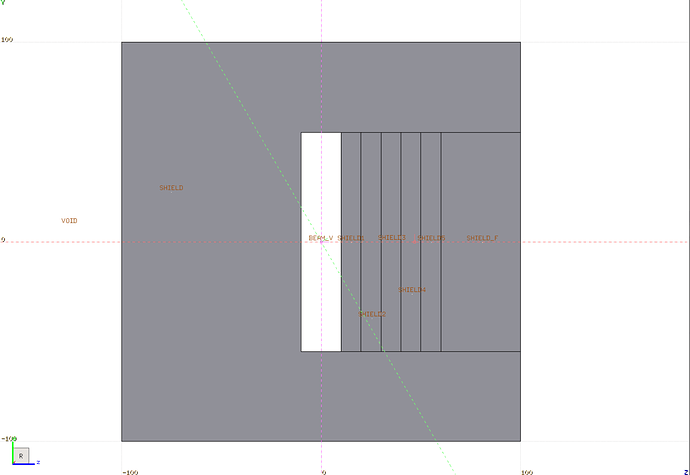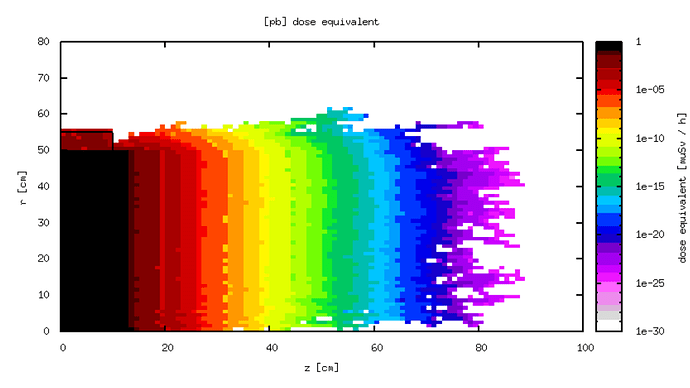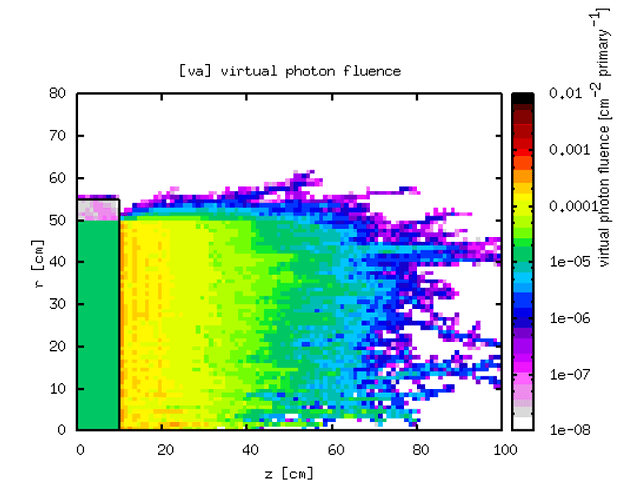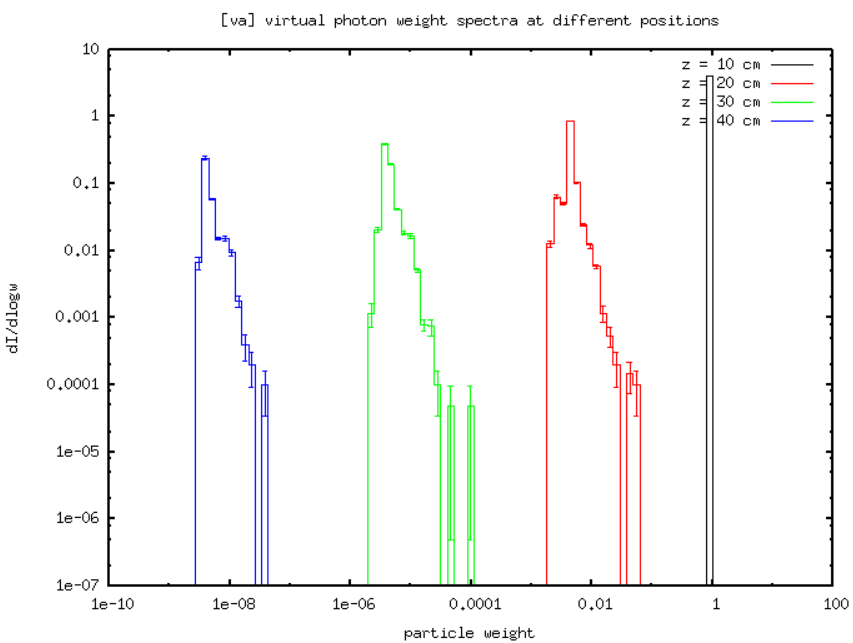Dear Fluka experts,
On learning that user biassing through usimbs can use the current weight of the particle in calculating the splitting or russian-rouletting ratio, I had an idea on how to use this for biasing and wanted to check if this is a sensible and safe approach. In short, the idea is to assign a narrow weight band to every position in space and to split or russian-roulette particles accordingly.
To describe/illustrate this I’ll be showing plots of this strategy with a really simple toy model of an 1 MeV photon beam incident on a lead slab.
weight-steering-biassing-main.zip (7.0 KB)
The beam is at x=y=z=0, and is a r=50 cm beam facing positive z, giving a uniform radiation distribution in the lead at z>10 cm.
The goal is to calculate the dose-equivalent over distance, which (with biasing) will give something like:
My intuition on biasing through shielding is that performance is best when the number of simulated particles entering the shielding is approximately the same as the number of particles leaving the shielding (neglecting any weight variations). To tune this, I’ve been abusing USERWEIG/fluscw to score the fluence of particles that are simulated in some region. In this model, with biasing this gives plots such as:
Note that this just spans six orders of magnitude (sensible as about 1e5 primaries were simulated), whereas the dose-equivelent generated with the same biassing and same number of primaries spans 25 orders of magnitude, indicating that the biasing is helping.
Now getting to the biassing itself: without biassing the decrease in dose-equivelent is largely caused by a decrease in simulated particles. It is better to instead decrease the weight of simulated particles, making the decrease in simulated particles less strong. This leads to the idea of some “target weight” at every position.
With usimbs being able to use the coordinates of the particle and the current weight of the particle, we can calculate the target weight at its new position and compare this with the current weight to check if we should be splitting or performing russian-roulette, and set FIMP accordingly.
In this simulation, I set the target weight as an exponential decay with a 1/10 length of some 3.5 cm, which is approximately the same 1/10 length as the dose-equivalent as can be seen in the earlier dose-equivalent figure.
If the current weight of a particle is more than 4x the target weight, FIMP = 2 to split the particle in two.
If the current weight is less than 1/4x the target weight, FIMP = 0.5 to russian roulette.
This strategy should keep the weights of particles in a band near the prescribed weight-distribution, also keeping the weight variation bound to approximately a factor of 16. The usimbs code of this biasing is as follows:
ZEND = ZTRACK(NTRACK)
* Biasing settings
BIASFT = 1.1d0
BIASL = 0.14d0
* weight starting point
WSTART = 1d0
BSTART = 10d0
* relative weight margin
WMARG = 4d0
* calculate importance of the current position
BIASIMP = BIASFT**NINT((ZEND-BSTART)/BIASL)
* calculate the target weight at the current position
WTARG = WSTART / BIASIMP
IF ( WTRACK .GT. WTARG * WMARG) THEN
* weight is too large
FIMP = 2d0
RETURN
ELSE IF ( WTRACK * WMARG .LT. WTARG) THEN
* weight is too small
FIMP = 1d0 / 2d0
RETURN
ELSE
* weight is fine
FIMP = ONEONE
RETURN
END IF
Using another trick with USERWEIGH/fluscw we can plot the weights of simulated particles at various interfaces, giving:
showing that indeed the current of simulated particles remains similar, but the weight is decreasing over z. The rather tight distribution of weights is also clear.
Using this biasing to score the physical dose-equivalent gives the first shown figure.
I found this strategy to be quite convenient in the first more serious project I used it in, as it by default keeps weight variation in check while not requiring too much tuning. The virtual fluence scoring makes the tuning quite straight-forward as well.
I am aware that doing in combination with lambda-biassing is somewhat risky, as lambda-biassing can cause weight fluctuations. The interaction with leading particle EMF biassing is less clear to me: while it should be safe to use I’m not sure how it affects (statistical) performance, if someone has ideas about this that would be appreciated.
I hope someone can give opinions on this being a useful strategy, if this strategy has the risk of giving misleading results or if there are different better ways of approaching usimbs biasing.
Regards,
Koen de Mare



